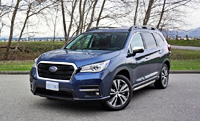
To say the mid-size crossover SUV category is growing would be quite the understatement. In fact, when brands might have once been satisfied with one single entry in either the two- or three-row sectors, now we’re seeing separate models addressing various families’ requirements, and then unique trim levels targeting luxury, sport, and off-road oriented buyers. If you’re a volume manufacturer, or even a niche player, trying to find success without a mid-size SUV in the lineup is like a company selling it wares without using social media. It’s not going to happen.
Prior to the new 2019 Ascent arrived on the market last autumn, Subaru had been AWOL from this critically important segment since its previous mid-size crossover, the 2005 to 2014 Tribeca, went out of production. That SUV was impressive for a number of reasons, particularly its premium-like refinement, but its styling and third-row spaciousness left would-be buyers searching elsewhere. After five years of contemplation, and no doubt designing and product planning, Subaru is back with a three-row mid-size crossover SUV that won’t disappoint anyone when it comes to size, plus it looks pretty good too.
Even though two-row crossover SUVs lead the mid-size sector in individual sales, Subaru already does well with its compact five-seat Forester and mid-size Outback crossover wagon, so it made sense for them to target larger families and those requiring more cargo space. They’re not alone, Honda having sold its three-row Pilot for 17 years ahead its new two-row Passport arriving this summer, so possibly we’ll see a bigger five-seat Subaru SUV at some point too.
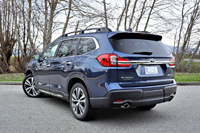
Until that happens, the North American-exclusive Ascent seats eight in standard form or seven with its optional second-row captain’s chairs, the latter configuration being how Subaru equipped my top-tier Premier tester. It’s a sizeable SUV, stretching 4,998 millimetres (196.8 inches) nose to tail with a 2,890-mm (113.8-inch) wheelbase, while its overall height stands 1,819 mm (71.6 inches) tall including its standard roof rails. What’s more, it measures 2,176 mm (85.6 inches) wide with its side mirrors extracted, plus its track spans 1,635 mm (64.4 inches) up front and 1,630 mm (64.2 inches) at the rear.
Putting this into perspective, the new Ascent is 48 mm (1.9 inches) shorter than the mid-size three-row SUV category’s top-selling Explorer, albeit with a 24-mm (0.9-inch) longer wheelbase, and some might be surprised to learn that the new Subaru SUV also stands 42 mm (1.6 inches) taller than the big Ford. The only Explorer dimension to exceed the Ascent is width that sees Ford’s SUV 119 mm (4.7 inches) wider, with 66 and 71 mm (2.6 and 2.8 inches) more respective front and rear track too. Considering the Explorer is one of the mid-size segment’s biggest crossover SUVs, Subaru now has something equally large so that no one gets left behind.
When comparing the new Ascent to other sales leaders, it’s longer, wider and taller than the Toyota Highlander and Kia Sorento (albeit shorter than the new Kia Telluride, with a shorter wheelbase and less width), longer and taller than the Honda Pilot and Hyundai Santa Fe XL (which is currently in its final days, but take note it’s slightly longer than the new Hyundai Palisade too, but its wheelbase isn’t, nor its width), wider and taller than the Nissan Pathfinder, merely wider than the Dodge Durango, and only taller than the Volkswagen Atlas.
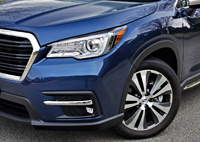
That was only a partial list of the Ascent’s three-row mid-size crossover SUV challengers, incidentally, the full list (from top-selling to poorest faring during the first three quarters of 2018) being the Explorer, Sorento, Highlander, Atlas, Pilot, Durango, Pathfinder, Chevrolet Traverse, Santa Fe XL, Dodge Journey, GMC Acadia, Mazda CX-9, and Ford Flex, while the just-mentioned Palisade and Telluride are too new to categorize by sales numbers.
While exterior size is one thing, passenger volume and cargo space is another, and much more important for making decisions. The Ascent provides 4,347 litres (153.5 cubic feet) of passenger volume and 2,449 litres (86.5 cu ft) for cargo when both rear rows are folded down. Those numbers are just for the most basic of Ascent trims, incidentally, which also measures 1,345 litres (47.5 cu ft) behind the 60/40-split second row and 504 litres (17.8 cu ft) behind the 60/40-split third row, while all other trims are half a litre less commodious at 2,435 litres (86.0 cu ft) behind the first row, 1,331 litres (47.0 cu ft) aft of the second row, and 498 litres (17.6 cu ft) in the very back.
These numbers compare well against key rivals, with the Ascent’s passenger volume even greater than the Explorer’s, and its standard eight-occupant seating layout a rarity in the class, while the big Subaru’s max cargo volume makes it one of the segment’s largest too. Also helpful, rear passengers gain easier access due to back doors that open up to 75 degrees.
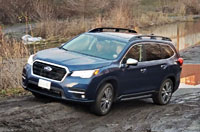
As with most Subaru models, the Ascent comes standard with full-time Symmetrical AWD, which has long proven to be amongst the more capable of all-wheel drive systems available. Its first advantage is more evenly balanced weight distribution thanks to a longitudinally mounted engine and transmission, compared to the AWD designs of competitors that mostly derive them from FWD chassis architectures incorporating transverse-mounted engines. Subaru’s horizontally opposed flat “boxer” engine also let the designers place it lower in the chassis resulting in a lower centre of gravity, which aids packaging and handling.
The Symmetrical AWD design automatically applies additional torque to the wheels with the most grip, and it’s done in such a way that traction not only improves when taking off from standstill in slippery conditions, but it also benefits overall control at higher speeds. This means the Ascent is very capable on all types of roads and trail surfaces, while its standard X-mode off-road system, together with hill descent control, as well as a sizeable 220 millimetres (8.66 inches) of ground clearance for overcoming rocks and stumps, snow banks, etcetera, makes it better for tackling tough terrain than most other crossover SUVs.
Of course I had to off-road it, and when facing the mud and muck I pressed the X-Mode button on the lower console and let it do the rest while I pointed it where I wanted to go. Amazingly it responded almost as well as the bull low gearing range of a truck-based 4×4, although the sound of all the electronic systems, such as traction and stability control, working away in the background as it climbed some very steep, ultra slippery, deeply rutted and just plain yucky sections of trail I would have normally only tried when at the wheel of a Jeep Wrangler, Toyota 4Runner, or something more dedicated to mucking it up, was out of the ordinary.
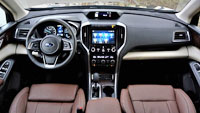
Fortunately the Ascent took care of my backside thanks to one of the nicer rides in the mid-size class, but I wouldn’t say it’s the sportiest feeling or best handling in this three-row category. It’s fully capable of being pushed hard through a twisting back road at a fast clip, but keep in mind this Subie was clearly designed for comfort before speed.
It rides on the new Subaru Global Platform (SGP) architecture, which combines a strong yet lightweight unibody construction with a fully independent MacPherson strut front and double-wishbone rear suspension, improved further with a stabilizer bar mounted directly to the body at the rear and an electric rack and pinion steering setup in front. It all rolls on 18-inch silver five-spoke alloys shod with 245/60 all-seasons in the Ascent’s two lower trims, and 20-inch machine-finished high-gloss split-spoke rims on 245/50 rubber for the two upper trims, my test model benefiting from the latter.
High-speed stability is important with an SUV that moves off the line as quickly as the Ascent. Its horizontally opposed 2.4-litre turbocharged four-cylinder makes 260 horsepower and 277 lb-ft of torque, the latter from 2,000 to 4,800 rpm, but I enjoyed it best when not pushing too hard, which bought out the powertrain’s wonderfully smooth character and minimized fuel usage.

Subaru estimates a Transport Canada five-cycle fuel economy rating of 11.6 L/100km city, 9.0 highway and 10.4 combined for the Ascent, compared to 12.0 city, 8.7 highway and 10.5 combined for the larger 3.6-litre H-6 in the much smaller Outback. The new four actually makes 4 more horsepower and 30 additional lb-ft of torque than the flat-six, by the way, so we’ll probably be seeing this smaller, more efficient turbocharged motor in a future Outback too.
Now that we’re making fuel economy comparisons, the Ascent looks good when put up against the base Explorer’s 2.3-litre turbocharged four that can only manage a claimed 13.1 L/100km in the city, 9.2 on the highway and 11.4 combined, but it should be said the blue-oval SUV makes a lot more power, whereas the thriftiest Toyota Highlander V6 AWD actually does quite well against both the Ford and Subaru SUVs at 11.7 city, 8.8 highway and 10.4 combined. All in all, the Ascent can hold its own at the pump.
Helping the Ascent achieve its impressive efficiency is Subaru’s High-torque Lineartronic CVT, continuously variable transmissions not only economical but also ideal for this type of large family-oriented vehicle thanks to its smooth, linear power delivery. Subaru includes standard steering wheel paddles to enhance driver engagement, along with a faux eight-speed manual shift mode that does a decent job of faking a regular automatic transmission’s gear changes while providing reasonably sporty driving characteristics, while standard Active Torque Vectoring increases high-speed traction. This advanced CVT was first introduced with Subaru’s WRX sport sedan, and while not optimized to swap cogs as quickly as in the World Rally Championship-bred performance car, it nevertheless combines positive, smooth operation while minimizing running costs.
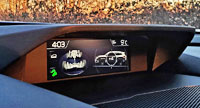
Compared to most of the Ascent’s mid-size competitors that come standard with FWD, AWD is standard and there’s only one powertrain on offer, from the base model to top-of-the-line. Trims in mind, the 2019 Ascent is available in Convenience, Touring, Limited and Premier grades, with its standard Convenience features including auto on/off halogen headlamps, LED daytime running lights (DRL), roof rails, a 4.2-inch colour TFT multi-information display, tri-zone auto HVAC, a 6.5-inch touchscreen infotainment system with Android Auto and Apple CarPlay smartphone connectivity, a backup camera, a six-speaker audio system with satellite radio, three-way heatable front seats, an eight-way powered driver’s seat, USB ports for the second row, 19 cup and bottle holders, plus more for only $35,995 plus destination.
Also impressive, all 2019 Ascent trims includes standard Subaru EyeSight driver assist technologies like adaptive cruise control with lead vehicle start assist, pre-collision braking, pre-collision brake assist, pre-collision throttle management, lane departure warning, lane sway warning, and lane keeping assist, while all the expected active and passive safety features come standard as well.
Moving up through the line, second-rung Touring trim starts at $40,995 in its eight-passenger configuration or $41,495 when the second-row captain’s chairs are added, the latter reducing the total number of seats to seven. The Touring model also includes the Subaru Rear/Side Vehicle Detection (SRVD) system that features blind spot detection, lane change assist, rear cross-traffic alert and reverse automatic braking, plus this trim also includes a special set of machine-finished five-spoke 18-inch alloy wheels, body-coloured side mirrors with integrated LED turn signals and approach lights, LED fog lights, a sportier looking rear bumper design featuring integrated tailpipe cutouts, proximity-sensing keyless entry, pushbutton start/stop, front door courtesy lamps, chromed inner door handles, a universal garage door opener, a windshield wiper de-icer, auto-dimming centre and sideview mirrors, a leather-clad steering wheel and shift knob, a bigger 8.0-inch centre touchscreen, more upscale fabric upholstery, a power panoramic sunroof, magazine pockets on the front seatbacks, climate controls for the second row passengers, reading lights for third row passengers, a retractable cargo cover, a power-operated tailgate, a transmission oil cooler, trailer stability control, and pre-wiring for a trailer hitch that increases towing capability to 2,270 kilos (5,000 lbs).
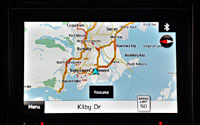
Next on the Ascent’s trim menu is the Limited, which starts at $46,495 in its standard eight-passenger configuration or $46,995 when set up for seven passengers, and adds the larger 20-inch alloy wheels noted before, plus steering-responsive full low/high beam LED headlamps with auto high beams, black and ivory soft-touch interior surfaces, a heated steering wheel rim, a nicer looking primary gauge package with chrome bezels and blue needles (instead of red), plus a 6.3-inch colour multifunction display on top of the centre dash that shows the time, temperature and dynamic functions including an inclinometer, while a navigation system gets added to the infotainment display, as does SiriusXM Traffic. Additional Limited trim features include 14-speaker 792-watt Harman/Kardon audio, a 10-way powered driver’s seat enhanced with powered lumbar support and lower cushion length adjustability, driver’s seat and side-mirror memory, a four-way powered front passenger seat, leather upholstery, two-way heated second-row seats, integrated rear door sunshades, third-row USB ports, plus more.
My tester’s Premier trim is top of the line yet at $49,995 it’s still very affordable, especially within a class that often exceeds the $50k threshold before adding options. The Ascent Premier comes fully equipped as is, including a special high-gloss black grille insert, satin-finish side mirror housings, chromed exterior door handles, rain-sensing windshield wipers, ambient interior lighting, a front-view camera, a Smart Rearview Mirror with an integrated rearview camera, woodgrain inlays, brown perforated leather upholstery, ventilated front seats, standard captain’s chairs for the second row, a 120-volt power outlet on the rear centre console, plus more.
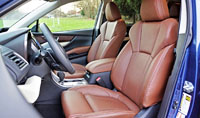
By the way, all 2019 Subaru Ascent prices were sourced right here on CarCostCanada, where you can also find detailed pricing on trims, packages and standalone options for every other new car, truck, van and crossover SUV sold in Canada, plus rebate information and dealer invoice pricing that could save you thousands.
Along with all the right features is a really nicely finished cabin that’s large and comfortable from front to back. Some noteworthy details include a leather-like soft-touch dash top enhanced with attractive stitching ahead of the front passenger, while just below is a useful shelf unpinned by a really nice bolster covered in more stitched leatherette, albeit ivory coloured for a truly distinct look. This wraps around lower portion of the instrument panel before matching up to more ivory bolstering on the door panels, although Subaru goes a step further by introducing a dark brown for the armrests that matches the previously noted brown leather seat upholstery. Premier trim also features matte-finish faux wood trim, but honestly it doesn’t come close to looking or feeling real. Last but not least, Subaru takes care of everyone’s elbows with soft padded synthetic door uppers front to back, but doesn’t go so far as to wrap any of the roof pillars in cloth like some others in the class.
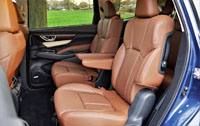
Speaking of not measuring up to the best this class has to offer, I was surprised to learn this top-line model doesn’t come with a fully digital gauge cluster, this advanced feature showing up on many of the Ascent’s recently redesigned or new competitors, like Volkswagen’s Atlas and Hyundai Palisade. Still, the dials’ blue needles were a nice addition instead of the usual red found in lower trims, while the vertical TFT multi-information display features a cool graphic of the SUV’s backside with taillights that light up when pressing the brake. It’s fun to watch, but even better this display notifies drivers via visual alert and audio chime that they may have left something, a young child, or possibly a pet in the back seat.
The bigger multi-information display on top of the dash is used more for Subaru’s EyeSight advanced driver assistance systems, with attractive, detailed graphics, while this display also provides speed limit information, navigation system info, an inclinometer and other off-road features, plus more.
Just underneath, Subaru’s impressive new high-resolution 3D-like infotainment touchscreen really wows the eyes as it provides a bevy of useful functions. It includes all the features and apps noted earlier, plus it responds to inputs quickly and reliably.
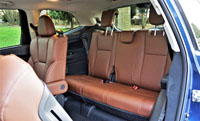
Fast responses in mind, the heatable steering wheel warms up quickly and remains hot as well, as do the heated front and rear seats, which I appreciate more than those that slowly cool off after a few minutes of maximum strength. I often use heated seats for therapeutic reasons, soothing an aching lower back, and the last thing I want is to keep fiddling with a temperature control switch. Speaking of switches, the button for heated steering wheel is smartly positioned just below the right-side spoke where it’s easy to locate, while the adaptive cruise control system, actuated via a set of buttons just above, worked ideally during high-speed and stop-and-go driving. Likewise, the lane departure system held the Ascent in place when cruising down the freeway, but rather than maintain the centre of a given lane it bounced off the lines when I purposely didn’t pay attention in order to test its capability.
A really impressive technology is the Ascent Premier’s auto-dimming centre mirror that does double-duty as a backup camera when activated. Also helpful is the Ascent’s sunglasses holder that doubles as a rear conversation mirror.
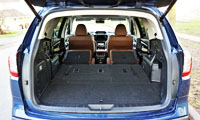
The Ascent’s driver’s seat was ultra-comfortable and quite wide, so it should be ideally shaped for big people, but it fit my five-foot-eight medium-build body type well too. When that front seat was positioned for my long-legged, short-torso frame, which means I had it pushed farther rearward than someone my height normally would, a far reaching telescopic steering wheel allowed for a comfortable driving position that left me in complete control. What’s more, when the seat was set up this way I still had plenty of room just behind in the second row seat, with approximately 10 inches of available space ahead of my knees and ample for me feet, plus loads for my hips and shoulders as well as more than enough over my head.
I was even more impressive with the third row. Just for fun I slid the second row as far back as possible and then climbed rearward, via a walkway that provided more than enough room. When seated in the very back my knees were rubbing up against the second-row seatbacks, but moving those seats forward a touch remedied the situation to the point that I had plenty of space in both rear rows. Really, there were three-plus inches above my head in the very back, which means average-size adults should fit in no problem, even while larger adults are seated just ahead.
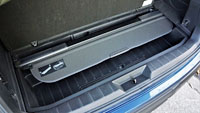
As I mentioned before, the Ascent provides a full load of cargo space behind the third row. In fact, it’s similar that found in a full-size sedan’s trunk, while below that load floor is a hidden compartment for storing smaller items plus the retractable cargo cover when not being used. Lowering the 60/40-split third row is slightly awkward, first needing the headrests to be manually pushed down into the seatbacks, and then requiring a tug on a strap hanging off the top of the seats, before pushing those seats down. Pulling them back up merely needs a tug on a longer strap attached to the cargo floor/seatback. As for the second row, it lays down by first unlatching it, so you can slide it forward, and then unlatching a second release at which point you can slide them back if you want to line up each side. There’s plenty of space for luggage and/or building sheets, but I must say the captain’s chairs don’t result in a particularly flat loading area. I imagine the standard bench seat would work better, so you may want to purchase one of the Ascent’s lower trims if you’re planning to do a lot of load hauling.
Purchasing in mind, you should feel safe buying an Ascent, even though it hasn’t been around very long. Subaru has a good track record for reliability and longevity, and after a week with this example I believe the automaker has done a very good job engineering and assembling its first-ever near full-size SUV.
Story credit: Trevor Hofmann
Photo credit: Karen Tuggay
